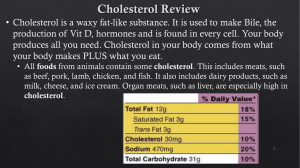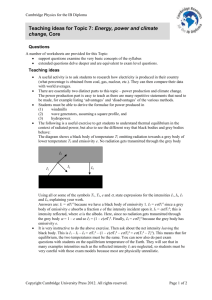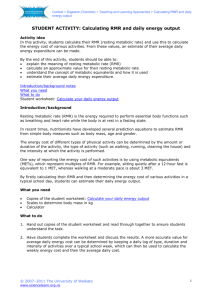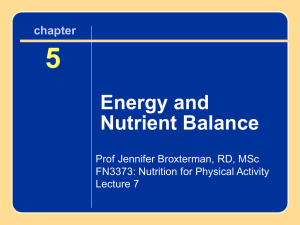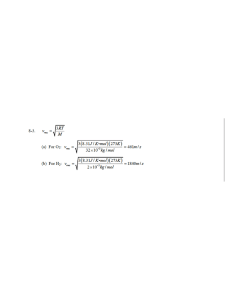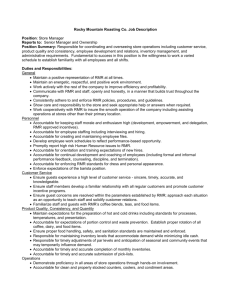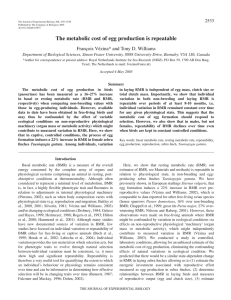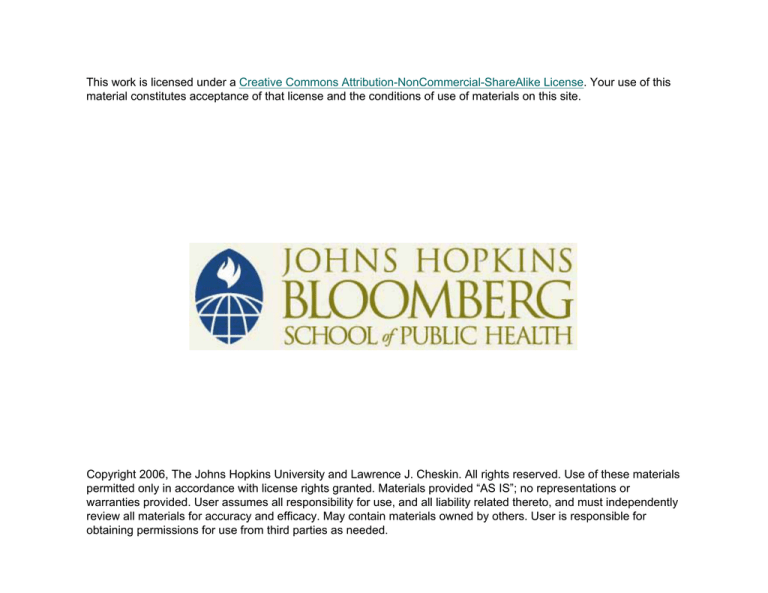
This work is licensed under a Creative Commons Attribution-NonCommercial-ShareAlike License. Your use of this
material constitutes acceptance of that license and the conditions of use of materials on this site.
Copyright 2006, The Johns Hopkins University and Lawrence J. Cheskin. All rights reserved. Use of these materials
permitted only in accordance with license rights granted. Materials provided “AS IS”; no representations or
warranties provided. User assumes all responsibility for use, and all liability related thereto, and must independently
review all materials for accuracy and efficacy. May contain materials owned by others. User is responsible for
obtaining permissions for use from third parties as needed.
Lecture 4:
Metabolism and Dieting
Critical Analysis of Popular Diets
and Supplements
Instructor: Lawrence J. Cheskin, M.D.
Associate Professor, International Health
Director, Johns Hopkins Weight Management Center
Components of Metabolic Rate
{
Terminology:
z
z
z
z
z
Basal metabolic rate (BMR) or
Resting metabolic rate (RMR or REE)
Thermic effect of feeding (TEF)
Activity energy expenditure (EEact)
Total daily energy expenditure
(TEE/TDEE)
Resting Metabolic Rate
What comprises RMR?
{ Organs with high energy needs total only
5% of body weight, yet use 58% of REE:
liver = 21% of total RMR; brain 20%; heart 9%;
kidneys 8% (heart and kidneys=highest EE/g)
{
{
{
Muscle EE is only 3% of heart’s g/g at rest,
but in total comprises 22% of RMR at rest
Adipose tissue is even lower g/g, and is
always at rest: 4% of RMR in lean, up to
10+% in obese
Remaining 16% is from skin, GI, lungs,
bones, etc
Gender, Age, Body Composition
{
{
{
Women have lower RMR than men
of same weight and height
RMR of child > adult >senior
% body lean determines RMR more
than % body fat
RMR Differences
{
{
Key point: obese often have higher
RMRs than expected because they have
excess muscle as well as excess fat
Of note: even after adjusting for
differences in muscle, fat-free mass
(FFM), and VO2-max, women have 3-10%
lower RMR than men
z
Causes are unclear: ? hormonal influence;
diffs in muscle fiber type, Na-K-ATPase
activity, neoglucogenesis activity, SympNS,
core temp
Hormonal influences on RMR
{
{
{
Catecholamines
(adrenaline/epinephrine, NE)
increase RMR by ~20%, via muscle,
heart adrenergic receptor
stimulation
Thyroxine (T4) and thyronine (T3)
can increase RMR by up to 80%
(days delay)
Leptin also can increase RMR and
EEact
Implications of Low/High RMR
{
In Pima Indians (genetically prone
to obesity and type-2 diabetes):
z
{
Risk of weight gain is much greater in
those with low-normal RMR c/w highnormal RMR
Genetic influences on RMR: present
z
Adjusted for weight, the 95% CI in
populations of normal adults spans +/250 kcal/d
Thermic Effect of Feeding (TEF)-1
{
{
{
{
{
Also called DIT (diet-induced
thermogenesis)
It is the energy cost of digestion,
absorption, processing and storage of
nutrients
Comprises about 10% of TEE in
sedentary
There are no significant age or gender
diffs
But obese seem to have lower TEFs
Thermic Effect of Feeding (TEF)-2
{
{
TEF increases with amount eaten, meal
frequency
TEF can be determined and varies by
macronutrient: macronutrient-specific
TEFs (by % of energy in the food used
as TEF when the food is completely
metabolized):
z
z
z
z
CHO: glucose 8%, starch slightly higher
Protein 20-30%
Fat 2%
Ethanol 22%
Energy Cost of Interconversion and
Storage
{
{
{
All macronutrients can be
interconverted
If it’s not used for fuel, conversion
of CHO to fat burns/wastes 23% of
the ATP energy in the CHO
Storing fat burns only 3% of the
energy in the fat
Measurement of Metabolism
{
{
{
{
{
Prediction equations
Indirect calorimetry
Direct calorimetry
Doubly-labeled water
Thyroid hormone levels (T4, TSH)
Prediction equations
Indirect calorimetry (IC)
Most accessible measure of actual physiology of
an individual; usually performed after overnight
fast
{ Can determine RMR, TEF, EEact
{ Immediate response, as O2 is not stored
Based on the observation that burning a mixed
fuel (absorbed food) produces 20.3 kJ of E for
every liter of O2 consumed at STP (dry):
{
M= 20.3 kJ/L x (VO2 max) in L/min
Where M = metabolic rate, in kJ/min
Indirect Calorimetry-2
{
{
Only O2 consumption is needed to
calculate EE, but IC also measures CO2
being produced
IC can thus determine fuel mix being
burned because specific fuels have
different ratios of CO2 produced to O2
consumed (the respiratory quotient, or
RQ):
Per gram of fuel (substrate) burned:
O2 used
CO2 produced
RQ
z
z
z
CHO:
0.83L
Protein: 1.01L
Fat
2.02L
0.83L
0.84L
1.43L
1.00
0.83
0.71
Direct calorimetry (DC)
{
{
{
{
{
Measures heat losses, not heat
produced
DC measures heat loss via
radiation, conduction, convection,
and evaporation in a speciallyconstructed, insulated room
Heat production begins ~20 min
into a meal
Heat loss begins later, so body
temp rises then falls after a meal
At steady state, heat production =
heat loss
Doubly-Labeled Water (DL H2O)
{
{
{
{
{
{
Uses the non-radioactive isotope 2H2O18
O18 rapidly exchanges between the O in water and the
O in CO2 (courtesy of carbonic anhydrase)
CO2 is exhaled, so the concentration of the body’s O18
declines, but the other label (2H) is stuck in H2O
The difference in the rate of turnover (loss) of the 2
labeled forms of H20 (doubly vs singly-labeled) is thus a
measure of the production rate for CO2
This loss is gauged by taking a saliva sample at day 14
and measuring the ratio of water isotopes
Thus, DL H20 measures EE over the prior 14 days, not
day-to-day EE
Thyroid Hormone Levels (T4, TSH)
{
{
{
{
{
{
Typical of the endocrine system, there are
multiple levels of control of thyroid hormones
T3 is the final active hormone
T4 is converted to T3
The pituitary gland produces TSH (thyroidstimulating hormone) which regulates T4/T3
The hypothalamus produces TRH (thyroid
releasing hormone) which regulates TSH
We measure TSH mostly: a high TSH= slow
thyroid function, hypothyroidism (high because
the pituitary attempts to flog a sluggish thyroid
gland)
Effect of weight loss on TEE
{
With weight loss, RMR declines in
proportion to the decline in fat-free
mass
z
{
TEF declines during a diet (less food
eaten)
z
{
This decline can be blunted by preserving
muscle mass through resistance training
TEF recovers once diet returns to normal
EEact declines as E cost of movement
declines
z
This decline can be blunted by increasing
activity level

